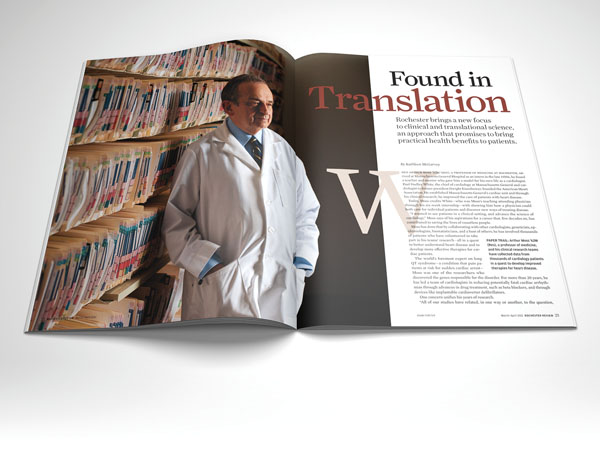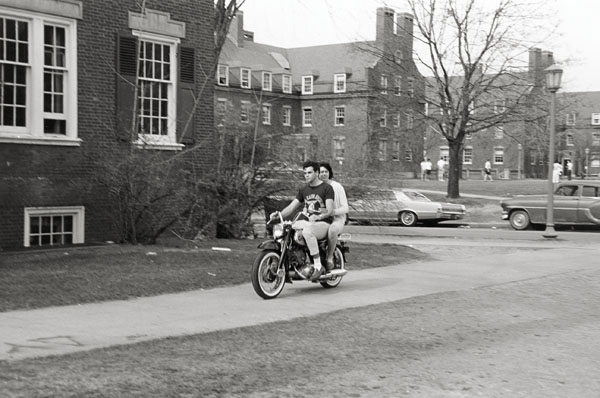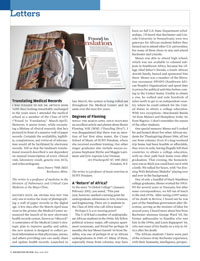Letters
 (Photo: Rochester Review)
(Photo: Rochester Review)Translating Medical Records
I was pleased to see Dr. Arthur Moss ’62M (Res) looking remarkably unchanged in the years since I attended the medical school as a member of the Class of 1979 (“Found in Translation,” March-April). However, it seems ironic, while recounting a lifetime of clinical research, that he’s pictured in front of a massive wall of paper records. Certainly the availability, legibility, completeness, and retrieval of information would all be facilitated by electronic records. Tell us that the landmark translational research described is not dependent on manual transcription of every clinical visit, laboratory result, genetic test, ECG, and echocardiogram.
Steve Peters ’79M (MD)
Rochester, Minn.
The writer is a professor of medicine in the Division of Pulmonary and Critical Care Medicine at the Mayo Clinic.
Editor’s Note: Dr. Peters was not the only one to notice the irony of photographing a wall of paper records in the digital age. A few days after the March-April issue went to the printer, the Medical Center announced the launch of its new electronic health records system, known as “eRecord.” A centerpiece of the Medical Center’s strategic plan to improve quality and safety, the new system is designed to collect patient information so that physicians, nurses, and others providing care can easily share and update health records. Launched in late March, the system is being rolled out throughout the Medical Center and its units over the next few years.
Degrees of Fleming
While the March-April issue featured an excellent article and photos about Renée Fleming ’83E (MM) (“Dazzling Diva”), I was disappointed that there was no mention of her first alma mater, the Crane School of Music of SUNY Potsdam, where she received excellent training. Our other singer graduates also include mezzo-sopranos Stephanie Blythe and Maggie Lattimore and lyric soprano Lisa Vroman.
Art Frackenpohl ’47, ’49E (MA)
Potsdam, N.Y.
The writer is a professor of music emeritus at SUNY Potsdam.
A ‘Return’ of Africa?
In the story “A Global College” (January-February 2011), you noted, “This past year, however, marked a turning point for undergraduate admissions to Arts, Sciences, and Engineering. There are 11 students in the Class of 2014 who call Africa home.”
Perhaps it is a re-turning point?
The U of R had a number of undergraduate African students in the 1960s. My fellow political science major, off-campus apartment roommate, and friend for perhaps 18 months, the late Moses Garoeb ’66 from Namibia, was one of perhaps 15 or so African undergraduates in 1965–67. Many of them, especially those from colonies, may have been on full U.S. State Department scholarships. I’d heard that Rochester and Lincoln University in Pennsylvania were two gateways for African students before they fanned out to attend other U.S. universities; but many of them chose to stay and attend Rochester and Lincoln.
Moses was able to attend high school, which was not available to colonial subjects in Southwest Africa, because his village chief father’s friends, a South African Jewish family, hosted and sponsored him there. Moses was a member of the liberation movement SWAPO (Southwest African People’s Organization) and spent time in prison for political activities before coming to the United States. Unable to obtain a visa, he walked and rode hundreds of miles north to get to an independent country, where he could embark for the United States to obtain a college education.
With two exceptions—Macdonald Banda ’65 from Malawi and Humphrey Iroku ’66 from Nigeria—I don’t remember the names of the other students.
One special memory: Moses and I cooked for and hosted about five other African students for Thanksgiving dinner 1966, all but one from colonies. Even if a long weekend trip home had been feasible or affordable, they were in exile, having illegally left their countries to obtain a college education, with no clear path back home even after graduation. That evening, the homesickness was so thick you could have cut it with a knife. We talked for hours, with “An Evening With Belafonte/Makeba” playing over and over in the background. One of only a handful of black Namibian college graduates,
Moses worked for SWAPO for several years in Tanzania, but after some correspondence, we fell out of touch in the mid-1970s. After seeing a 1997 notice of his death in Review, I found out he was part of the Namibian government after liberation, serving as the minister of labor for several years. I heard more about him from Rochester alumnus George Ward ’65, the former ambassador to Namibia who met him in the 1990s, and Louis Rappaport ’66, who met some of his family on a trip to Africa after his death.
The African students I knew were part of the richness of my Rochester experience, with their humanity, intelligence, perspectives, and the experiences they shared, as much a part of my education as coursework. That experience added to my comfort level with people from diverse backgrounds, not part of my childhood in homogenous white suburbs, which helped in my later work with race relations.
I don’t know how many of these earlier African alumni have maintained contact with U of R, but it would be great to contact them and find out what they’ve accomplished against the impossible odds facing them on return.
Based on Wangari Maathai’s comments (the Nobel Prize winner from Kenya) in a documentary that her education in the United States was an important foundation for her environmental and political activism, perhaps we will discover that their education at the U of R had an equally positive impact on their lives and accomplishments?
Daniel Schesch ’67
St. Louis, Mo.
The writer is a cofounder of Bridges Across Racial Polarization.
Conserving More History
I was excited to see art conservation featured in the March-April issue. (“Conserving University History,” In Review). Our field of art conservation reflects the interdisciplinary education that I enjoyed at Rochester, combining chemistry and engineering with fine arts skills and art historical connoisseurship. After graduating in May 2010 with a BA in art history and Spanish I began what is known as a “preprogram” internship at West Lake Conservators in Skaneateles, N.Y. So far it’s been challenging and a lot of fun. I also have the pleasure of working with Rochester alumnus John Sutton ’68, ’69W (MA), who is a senior paintings conservator at West Lake.
One of our recent projects focused on a mural depicting Col. Nathaniel Rochester. Painted by Carl Raschen, it used to hang in a hotel in downtown Rochester and is now owned by the Rochester Historical Society.
Emily Wroczynski ’10
Auburn, N.Y.
 (Photo: University Libraries/Department of Rare Books, Special Collections and Preservation)
(Photo: University Libraries/Department of Rare Books, Special Collections and Preservation)Remembering the Motorcyclists
We received several notes from alumni in response to the undated photo of students riding a motorcycle on the Fraternity Quad that we featured as the opening photo of Class Notes for the March-April issue. Thanks to all who wrote—Editor.
Although I do not know the couple riding the motorcycle, I can identify the motorcycle as a 1960s Honda CC 160. This became something of a famous classic model and was called the “Dream Machine.” Honda produced these for several years in the 1960s without naming any specific year. The model has a flared front fender, whitewall tires and is all black and chrome, although they made a model that is white and chrome. I happened to own two of these in black and eventually sold them as antiques for much more than I originally paid.
Richard Merrell ’63E (MM)
We can identify the black and white photograph in the March-April issue.
The lady riding on the motorcycle is Jeanne Tapp Ozols ’67, ’70W (MA). She’s being taken to the Delta Kappa Epsilon fraternity house for an afternoon weekend party by Bud Wilcox, the fraternity “little brother” of Dr. Robert Ozols ’66, ’71M (PhD), ’74M (MD). We are quite certain that it was taken in 1965.
Bob and Jeanne married after her graduation and have been married for 43 years. They have three children and two grandchildren and live in Solebury, Pa.
Jeanne Tapp Ozols ’67, ’70W (MA)
Robert Ozols ’66, ’71M (PhD), ’74M (MD)
Solebury, Pa.
The picture on page 41 of the March-April issue brings back many of the bittersweet memories of that time. The gentleman on the motorcycle is Armour David (Bud) Wilcox III. He left school shortly thereafter to fight for his country. He became a sergeant in the 9th Infantry Division of the U.S. Army. Tragically, he was killed in action during a firefight at Dinh Tuong, South Vietnam, on Dec. 8, 1968.
Dave was a member of Delta Kappa Epsilon. As president of the fraternity at the time, I received a long letter from his father in the winter of 1969 addressed to the entire brotherhood. Handwritten, it went on to describe how proud he was of his son and the sacrifice he had made.
It broke our hearts.
David Wilson ’69, ’74S (MBA)
Cohasset, Mass.
Memories of Susan B?
Next year marks the 25th anniversary of the Susan B. Anthony Institute for Gender and Women’s Studies at the University. In preparation for the yearlong series of events to mark this milestone, we are interested in hearing from alumnae (and alumni!) of any traditions at the University connected with Susan B. Anthony, especially from the years before 1986. Please send any memories or thoughts to sbai@rochester.edu.
Honey Meconi
Director, Susan B. Anthony Institute for Gender and Women’s Studies
Review welcomes letters and will print them as space permits. Letters may be edited for brevity and clarity. Unsigned letters cannot be used. Send letters to Rochester Review, 22 Wallis Hall, P.O. Box 270044, University of Rochester, Rochester, NY 14627-0044; rochrev@rochester.edu.

